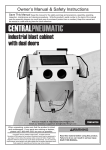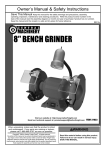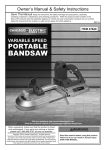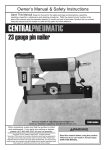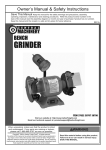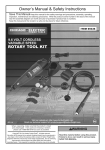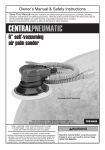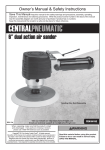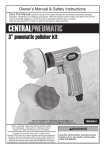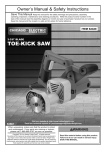Download Harbor Freight Tools 2_1/2 HP 9 in. Benchtop Band Saw Product manual
Transcript
Table of Contents Safety Safetye��������������������������������������������������������� 2 Specifications.............................................. 6 Setup........................................................... 6 Operationa���������������������������������������������������� 8 Maintenancei���������������������������������������������� 11 Parts List and Diagram............................... 14 Warranty..................................................... 16 WARNING SYMBOLS AND DEFINITIONS Setup This is the safety alert symbol. It is used to alert you to potential personal injury hazards. Obey all safety messages that follow this symbol to avoid possible injury or death. Indicates a hazardous situation which, if not avoided, will result in death or serious injury. Indicates a hazardous situation which, if not avoided, could result in death or serious injury. Indicates a hazardous situation which, if not avoided, could result in minor or moderate injury. Addresses practices not related to personal injury. Operation IMPORTANT SAFETY INFORMATION General Tool Safety Warnings Read all safety warnings and instructions. Failure to follow the warnings and instructions may result in electric shock, fire and/or serious injury. Save all warnings and instructions for future reference. 1. KEEP GUARDS IN PLACE and in working order. Maintenance 2. REMOVE ADJUSTING KEYS AND WRENCHES. Form habit of checking to see that keys and adjusting wrenches are removed from tool before turning it on. 5. KEEP CHILDREN AWAY. All visitors should be kept safe distance from work area. 6. MAKE WORKSHOP KID PROOF with padlocks, master switches, or by removing starter keys. 3. KEEP WORK AREA CLEAN. Cluttered areas and benches invite accidents. 7. DON’T FORCE TOOL. It will do the job better and safer at the rate for which it was designed. 4. DON’T USE IN DANGEROUS ENVIRONMENT. Don’t use power tools in damp or wet locations, or expose them to rain. Keep work area well lighted. 8. USE RIGHT TOOL. Don’t force tool or attachment to do a job for which it was not designed. Page 2 For technical questions, please call 1-800-444-3353. Item 60500 General Tool Safety Warnings (cont.) 0–6 18 16 16 14 6.1 – 10 18 16 14 12 10.1 – 12 16 16 14 12 12.1 – 16 14 12 Do not use. 9. USE PROPER EXTENSION CORD. Make sure your extension cord is in good condition. When using an extension cord, be sure to use one heavy enough to carry the current your product will draw. An undersized cord will cause a drop in line voltage resulting in loss of power and overheating. Table A shows the correct size to use depending on cord length and nameplate ampere rating. If in doubt, use the next heavier gauge. The smaller the gauge number, the heavier the cord. 10. WEAR PROPER APPAREL. Do not wear loose clothing, gloves, neckties, rings, bracelets, or other jewelry which may get caught in moving parts. Nonslip footwear is recommended. Wear protective hair covering to contain long hair. 11. ALWAYS USE SAFETY GLASSES. Also use face or dust mask if cutting operation is dusty. Everyday eyeglasses only have impact resistant lenses, they are NOT safety glasses. 16. REDUCE THE RISK OF UNINTENTIONAL STARTING. Make sure switch is in off position before plugging in. 17. USE RECOMMENDED ACCESSORIES. Consult the owner’s manual for recommended accessories. The use of improper accessories may cause risk of injury to persons. 18. NEVER STAND ON TOOL. Serious injury could occur if the tool is tipped or if the cutting tool is unintentionally contacted. 19. CHECK DAMAGED PARTS. Before further use of the tool, a guard or other part that is damaged should be carefully checked to determine that it will operate properly and perform its intended function – check for alignment of moving parts, binding of moving parts, breakage of parts, mounting, and any other conditions that may affect its operation. A guard or other part that is damaged should be properly repaired or replaced. 20. DIRECTION OF FEED. Feed work into a blade or cutter against the direction of rotation of the blade or cutter only. 21. NEVER LEAVE TOOL RUNNING UNATTENDED. TURN POWER OFF. Don’t leave tool until it comes to a complete stop. Maintenance 12. SECURE WORK. Use clamps or a vise to hold work when practical. It’s safer than using your hand and it frees both hands to operate tool. 15. DISCONNECT TOOLS before servicing; when changing accessories, such as blades, bits, cutters, and the like. Safety (at full load) 14. MAINTAIN TOOLS WITH CARE. Keep tools sharp and clean for best and safest performance. Follow instructions for lubricating and changing accessories. Setup NAMEPLATE AMPERES EXTENSION CORD LENGTH 25′ 50′ 100′ 150′ 13. DON’T OVERREACH. Keep proper footing and balance at all times. Operation Table A: RECOMMENDED MINIMUM WIRE GAUGE FOR EXTENSION CORDS (120 VOLT) Item 60500 For technical questions, please call 1-800-444-3353. Page 3 Grounding Instructions Safety TO PREVENT ELECTRIC SHOCK AND DEATH FROM INCORRECT GROUNDING WIRE CONNECTION READ AND FOLLOW THESE INSTRUCTIONS: 110-120 V~ Grounded Tools: Tools with Three Prong Plugs 1. In the event of a malfunction or breakdown, grounding provides a path of least resistance for electric current to reduce the risk of electric shock. This tool is equipped with an electric cord having an equipment-grounding conductor and a grounding plug. The plug must be plugged into a matching outlet that is properly installed and grounded in accordance with all local codes and ordinances. Setup 2. Do not modify the plug provided – if it will not fit the outlet, have the proper outlet installed by a qualified electrician. 3. Improper connection of the equipment-grounding conductor can result in a risk of electric shock. The conductor with insulation having an outer surface that is green with or without yellow stripes is the equipment-grounding conductor. If repair or replacement of the electric cord or plug is necessary, do not connect the equipmentgrounding conductor to a live terminal. Operation 4. Check with a qualified electrician or service personnel if the grounding instructions are not completely understood, or if in doubt as to whether the tool is properly grounded. 5. Use only 3-wire extension cords that have 3-prong grounding plugs and 3-pole receptacles that accept the tool’s plug. 6. Repair or replace damaged or worn cord immediately. Grounding Pin 125 V~ 3-Prong Plug and Outlet (for up to 125 V~ and up to 15 A) 7. This tool is intended for use on a circuit that has an outlet that looks like the one illustrated above in 125 V~ 3-Prong Plug and Outlet. The tool has a grounding plug that looks like the plug illustrated above in 125 V~ 3-Prong Plug and Outlet. 8. The outlet must be properly installed and grounded in accordance with all codes and ordinances. 9. Do not use an adapter to connect this tool to a different outlet. Band Saw Safety Warnings For Your Own Safety Read Instruction Manual Before Operating Saw 1. Wear eye protection. 2. Do not remove jammed cutoff pieces until blade has stopped. 7. DO NOT OPERATE WITH ANY GUARD DISABLED, DAMAGED, OR REMOVED. 8. Remove Key after use and before removing a jammed workpiece. 9. Secure properly to a hard, level surface before use. Maintenance 3. Maintain proper adjustment of blade tension, blade guides, and thrust bearings. 10. Hot motor! To prevent injury, do not touch motor during, or immediately after, use. 4. Adjust upper guide to just clear workpiece. 11. The use of accessories or attachments not recommended by the manufacturer may result in a risk of injury to persons. 5. Hold workpiece firmly against table. 6. Use special care when unpacking or replacing bandsaw blade. Blade can be under tension and may suddenly uncoil. Wear ANSI‑approved safety glasses under a full face shield and heavy-duty work gloves. Page 4 12. When servicing use only identical replacement parts. For technical questions, please call 1-800-444-3353. Item 60500 15. Industrial applications must follow OSHA guidelines. 16. Maintain labels and nameplates on the tool. These carry important safety information. If unreadable or missing, contact Harbor Freight Tools for a replacement. 17. Avoid unintentional starting. Prepare to begin work before turning on the tool. 18. People with pacemakers should consult their physician(s) before use. Electromagnetic fields in close proximity to heart pacemaker could cause pacemaker interference or pacemaker failure. 19. WARNING: Some dust created by power sanding, sawing, grinding, drilling, and other construction activities, contains chemicals known [to the State of California] to cause cancer, birth defects or other reproductive harm. 20. WARNING: Handling the cord on this product will expose you to lead, a chemical known to the State of California to cause cancer, and birth defects or other reproductive harm. Wash hands after handling. (California Health & Safety Code § 25249.5, et seq.) 21. The warnings, precautions, and instructions discussed in this instruction manual cannot cover all possible conditions and situations that may occur. It must be understood by the operator that common sense and caution are factors which cannot be built into this product, but must be supplied by the operator. Vibration Safety 1. Anyone using vibrating tools regularly or for an extended period should first be examined by a doctor and then have regular medical check‑ups to ensure medical problems are not being caused or worsened from use. Pregnant women or people who have impaired blood circulation to the hand, past hand injuries, nervous system disorders, diabetes, or Raynaud’s Disease should not use this tool. If you feel any medical or physical symptoms related to vibration (such as tingling, numbness, and white or blue fingers), seek medical advice as soon as possible. 2. Do not smoke during use. Nicotine reduces the blood supply to the hands and fingers, increasing the risk of vibration-related injury. 3. Use tools with the lowest vibration when there is a choice between different processes. 4. Include vibration-free periods each day of work. 5. Grip tool as lightly as possible (while still keeping safe control of it). Let the tool do the work. 6. To reduce vibration, maintain the tool as explained in this manual. If any abnormal vibration occurs, stop use immediately. Maintenance This tool vibrates during use. Repeated or long-term exposure to vibration may cause temporary or permanent physical injury, particularly to the hands, arms and shoulders. To reduce the risk of vibration-related injury: SAVE THESE INSTRUCTIONS. Item 60500 Setup 14. Stay alert, watch what you are doing and use common sense when operating a power tool. Do not use a power tool while you are tired or under the influence of drugs, alcohol or medication. A moment of inattention while operating power tools may result in serious personal injury. Some examples of these chemicals are: • Lead from lead-based paints • Crystalline silica from bricks and cement or other masonry products • Arsenic and chromium from chemically treated lumber Your risk from these exposures varies, depending on how often you do this type of work. To reduce your exposure to these chemicals: work in a well ventilated area, and work with approved safety equipment, such as those dust masks that are specially designed to filter out microscopic particles. (California Health & Safety Code § 25249.5, et seq.) Operation 13. Only use safety equipment that has been approved by an appropriate standards agency. Unapproved safety equipment may not provide adequate protection. Eye protection must be ANSI-approved and breathing protection must be NIOSH-approved for the specific hazards in the work area. Safety Band Saw Safety Warnings (cont.) For technical questions, please call 1-800-444-3353. Page 5 Specifications Safety Electrical Rating 120V~ / 60Hz / 2.5A Motor No Load Speed 1725 RPM Blade Speed 2460 FPM Throat Depth 9″ Table Pivot (Tilt) Capacity 0~45° (Right Tilt Only) Blade Size 1/8″ – 1/2″ W x 0.01″ T x 62″ L Miter Gauge 0~60° Left & Right Miter Slot 5/8″ W x 1/4″ D Base Mounting Holes 4 x 3/8″ Diameter Setup - Before Use: Setup Read the ENTIRE IMPORTANT SAFETY INFORMATION section at the beginning of this manual including all text under subheadings therein before set up or use of this product. TO PREVENT SERIOUS INJURY FROM ACCIDENTAL OPERATION: Turn the Power Switch of the tool off and unplug the tool from its electrical outlet before performing any procedure in this section. Note: For additional information regarding the parts listed in the following pages, refer to the Assembly Diagram near the end of this manual. Operation Mounting 1. This tool must be mounted to a level, stable bench or table before use. 2. If the mounting surface does not have predrilled holes that match the four holes in the Base (70) of the Band Saw, four 3/8″ holes will have to be drilled. 3. CAUTION! When drilling, check for electric wiring or cables that may be in the path of the hole(s) being drilled. 4. Secure the Band Saw to the surface by using 3/8″ bolts, 3/8″ washers and 3/8″ hex-nuts (not included). Maintenance Page 6 For technical questions, please call 1-800-444-3353. Item 60500 Assembly 2. Slide the slot in the Table (8) around the Blade. Position the Table (8) onto the Saw over the two posts. Then, pull out and release the Tilt Knob (19) to help align the Table. Table (8) 3. Secure the Table (8) using Tilt Lock (12) and Flat Washer (13) through the hole shown above. Leave the Tilt lock slightly loose for now. 4. Use a square (sold separately) to set Table (8) perpendicular (90° angle) to Saw Blade (111) and tighten the Tilt Lock (12) to secure the Table in place. 5. Loosen the Indicator Screw (119), turn the Tilt Indicator (117) around to face the scale, align the Tilt Indicator to 0° on the scale, and hold it still while tightening the Indicator Screw. Safety 1. Unpack the Table (8) and remove the protective cover. 6. Remove the Table Insert (9) from the Wing Bolt (11). Insert the Insert into the end of the slot on the Table (8). Tilt Knob (19) Tilt Indicator (117) Insert the Wing Bolt and Spring Washer (10) up through the slot and into the Table Insert (9) and tighten to secure. Table Insert (9) Table (8) Spring Washer (10) Maintenance Operation Wing Bolt (11) Setup Connect Tilt Lock (12) here Indicator Screw (119) Item 60500 For technical questions, please call 1-800-444-3353. Page 7 b. b. How the adjustments should be made. Operating Instructions Read the ENTIRE IMPORTANT SAFETY INFORMATION section at the beginning of this manual including all text under subheadings therein before set up or use of this product. Safety Tool Set Up TO PREVENT SERIOUS INJURY FROM ACCIDENTAL OPERATION: Turn the Power Switch of the tool off and unplug the tool from its electrical outlet before performing any procedure in this section. TO PREVENT SERIOUS INJURY: DO NOT OPERATE WITH ANY GUARD DISABLED, DAMAGED, OR REMOVED. TO PREVENT INJURY: Wear heavy-duty work gloves and ANSI-approved safety goggles whenever handling blade. DO NOT WEAR GLOVES WHILE SAWING. Setup Blade Selection Band Saw blade selection depends on the type of material to be cut, the size of the workpiece and the type of cut desired: 1. The blade width is the distance from the tip of a tooth to the back of the blade. Wider blades are more rigid, wander less and provide a straighter cut. Narrower blades handle curved cuts better. Operation 2. The blade thickness is the distance between the two sides of a blade. A thicker blade is more rigid and has stronger teeth. A narrow blade is used to make long, straight cuts with less waste. 3. The blade pitch describes the number of teeth per inch (TPI). The more TPI, the smoother (and usually slower) the cut. The type of material being cut determines the blade pitch. For soft materials the correct blade should have 6-8 TPI. If hard materials are being cut, use a blade with 8-12 TPI for best results. Note: There must be at least 3 teeth in contact with the material1 to prevent “blade shocking”. This happens when the blade pitch is too large and a blade tooth contacts too much of the workpiece. This might possibly strip teeth from your saw blade. Note: The included blade is 1/4″ wide x 0.01″ thick x 6 TPI. 1 TPI must be at least 3 divided by material thickness in inches to prevent blade shocking. Maintenance Page 8 For technical questions, please call 1-800-444-3353. Item 60500 Blade Adjustment Controls 7. Check tracking by rotating upper Blade Wheel (56) by hand in a clockwise direction. View Saw Blade (111) through Tracking Window (99). Tracking Knob (29) Blade Release Lever (27) 1. This allows quick changing of the Blade. Turn it counterclockwise to the down position shown above to release the blade. Turn it clockwise so it is pointing up to restore tension to the blade. 2. The Blade Release Lever should also be released before storing the Saw for long periods and before transporting the Saw. The Blade will need to be properly tensioned and tracked after tension is reapplied. Tension Knob (66) 3. Switch off the Band Saw, unplug it, and make sure the Blade Release Lever (27) is in the up position before proceeding. 4. Turn Tension Knob (66) clockwise for more blade tension and counterclockwise for less blade tension. 5. Wear heavy-duty work gloves, then open the Upper Wheel Cover (95) and press on the blade on the center of a span to check the tension. They blade should deflect slightly with finger pressure when tensioned properly. Close the Upper Wheel Cover. 8. Proper tracking is achieved when Saw Blade (111) runs centered on the wheel. Minor adjustments can be made using Tracking Knob (29). 9. As the Upper Blade Wheel (56) rotates, if the Blade moves away from the Knob, turn the Tracking Knob (29) slightly clockwise. If it moves toward the Knob, turn the Tracking Knob (29) slightly counterclockwise. Setup in released position 10. Close the Upper Wheel Cover (95). Blade Guide Alignment 11. The Blade Guides (37) support the saw blade at the rear and sides. They prevent twisting and help to keep the blade from being deflected by the workpiece. The blade guides should not touch the blade when a workpiece is not in contact with the blade. Note: Adjust Blade Guides only after the blade has been properly tensioned, and is tracking correctly. 12. Adjust the Upper Blade Guide by loosening Flat‑Head Screws (44) at front of Guide Block (45) and moving the Pin (46) toward sides of the Saw Blade (111). Use a feeler gauge (not included) to space Guide Block (45) .002″ from Saw Blade (111). Adjust the Bearing (41) at the rear of the Saw Blade (111) by loosening Hex‑Head Screw (39.1) and turning the Bearing Shaft. 13. Adjust the height of the Upper Blade Guide to clear the workpiece by loosening the Guide Knob (33) and adjusting the height of the Upper Guide until it clears the workpiece by 1/4″. 14. Adjust the Lower Blade Guides by loosening the Flat-Head Screws (44) and moving the Pin (46) away from the sides of the Saw Blade (111). Loosen the Bolt (47) and adjust the Lower Guide Block (49) so the rear of the Saw Blade (111) is positioned .002″ away from Bearing (41). Use a feeler gauge (not included) to check correct distance. Tighten Hex‑Head Screw (47). Tighten the Flat-Head Screws (44). Item 60500 Safety 6. Switch off the Band Saw, unplug it, and make sure that the blade is properly tensioned and the Blade Release Lever (27) is in the up position before proceeding. Open the Upper Wheel Cover (95). For technical questions, please call 1-800-444-3353. Page 9 Operation Blade Release Lever (27) Tracking Knob (29) Maintenance Tension Knob (66) Workpiece and Work Area Set Up 1. Designate a work area that is clean and well‑lit. The work area must not allow access by children or pets to prevent distraction and injury. Safety 2. Route the power cord along a safe route to reach the work area without creating a tripping hazard or exposing the power cord to possible damage. The power cord must reach the work area with enough extra length to allow free movement while working. 3. Secure loose workpieces using a vise or clamps (not included) to prevent movement while working. A workpiece that hangs over the edge of the Table (8) 5 inches or more needs to be supported properly. 4. There must not be objects, such as utility lines, nearby that will present a hazard while working. General Operating Instructions TO PREVENT SERIOUS INJURY FROM ENTANGLEMENT: Keep hands clear of Blade (111) at all times and do not wear gloves when sawing. Setup Note: The blade is not tensioned during shipment to prevent damage. It must be properly tensioned and tracked before use, see Blade Adjustment Controls on page 9. Table (8) Miter Gauge Bar (6) 1. Types of cut Miter Gauge Scale (3) a. Standard cuts are at 90° angle to the Table (8). Use a push stick to guide the workpiece through the Saw Blade (111). b. Contour cuts are accomplished by guiding the workpiece free-handed for curve shapes. When using this guiding method, use both hands to follow the desired path and keep the workpiece flat against the Table (8). Stand in front of the Table (8) and use both hands over the part of the Table (8) to the right of the Blade (111). Operation c. Bevel cuts are when the saw Table (8) is tilted and proper work guide methods are used. Unlock the Table (8) by loosening the Lock Screw (12) on the underside of the Table (8). Tilt Table (8) to correct angle using the Tilt Knob (19). When correct angle is achieved, tighten the Lock Screw (12). Guide Height Knob (108) Figure 2 3. This Band Saw is designed for cutting hard and soft woods and most plastics. It is equipped with a Miter Gauge Scale (3) used to secure the workpiece at a desired angle to produce angle cuts. Use the built-in Scale to adjust the Miter Gauge (3) to the required angle. See Figure 2. 4. Turn on Band Saw using Switch (93) and allow it to reach to full speed before beginning to saw. 5. Use push-sticks, or blocks (when required) to move workpiece through the Blade. Use a smooth, steady action to feed work through the blade. 6. Make sure the workpiece feeds against the toothed side of the Blade. Blade Guide (37) Guide Lock Knob (33) Maintenance 2. Adjust the height of the upper Blade Guide (37) to barely clear the workpiece. Loosen the Guide Lock Knob (33). Turn the Guide Height Knob (108) to adjust the Guide height. Tighten the Guide Lock Knob (33) after adjusting. Page 10 7. To prevent accidents, turn off the tool and disconnect its power supply after use. Clean, then store the tool indoors out of children’s reach. For technical questions, please call 1-800-444-3353. Item 60500 Maintenance and Servicing Safety Procedures not specifically explained in this manual must be performed only by a qualified technician. TO PREVENT SERIOUS INJURY FROM ACCIDENTAL OPERATION: Turn the Power Switch of the tool off and unplug the tool from its electrical outlet before performing any procedure in this section. TO PREVENT SERIOUS INJURY FROM TOOL FAILURE: Do not use damaged equipment. If abnormal noise or vibration occurs, have the problem corrected before further use. • blade straightness and teeth sharpness, • vibration-free operation, 5. Shielded Ball Bearings do not need lubrication. Small amounts of lightweight machine oil can be applied to belt tension mechanisms and sliding surfaces. 6. Paste wax can be applied occasionally to Table Top (8) to keep it slick and corrosion free. • loose hardware, • misalignment or binding of moving parts, • cracked or broken parts, • damaged electrical wiring, and • any other condition that may affect its safe operation. 2. Do not allow saw dust to accumulate on or in Band Saw. 3. Keep the Wheels clean. Debris on Wheels will cause poor tracking and possible Blade slippage. 8. If storing for a long period, release tension on the Blade by rotating the Blade Release Lever to the down position. The blade’s tension and tracking will need to be adjusted after thus storing. 9. WARNING! If the supply cord of this power tool is damaged, it must be replaced only by a qualified service technician. 10. Clear all saw dust from Dust Tube (69) at base of Band Saw. Do not let dust accumulate. Use a shop vacuum (not provided) attached as a dust collector when possible, and attach it to the Dust Tube (69). Occasionally, vacuum out entire Band Saw. Maintenance 4. Keep mechanisms and sliding surfaces clean and free of debris. 7. AFTER USE, disconnect from power source, clean by brushing and wiping with clean, moist cloth. Operation 1. BEFORE EACH USE, inspect the general condition of the tool. Check for: Setup Cleaning, Maintenance, and Lubrication Item 60500 For technical questions, please call 1-800-444-3353. Page 11 Installing Band Saw Blade 1. Turn the Switch (93) to its OFF position and unplug the power cord. Safety 2. Wear ANSI-approved safety goggles and heavy‑duty work gloves while handling the blade. 3. Move Blade Release Lever (27) down to the release position. 4. Unlatch and open Upper and Lower Wheel Covers (95, 102) exposing Saw Blade (111) and the Upper and Lower Wheels (56, 82). 6. Slip new blade through Table Blade Insert (7) and over Upper and Lower Wheels. Slide new blade between Blade Guide and Guide Block (37 & 45). 7. Turn the Blade Release Lever (27) up to the engaged position. 8. Close Upper and Lower Wheel Covers (95, 102) and fasten latches. Make sure that both doors and frames are fitted together before attempting to secure. This is necessary for proper operation of dust collection system. 9. Adjust tension and track Saw Blade (111) as described in Blade Adjustment Controls on page 9. Setup Blade Guide Cover (38) 5. Hold open the Blade Guide Cover (38) while installing the saw blade. Point the blade’s teeth down towards Table (8), as shown on the label on the Blade Guide Cover. Turn the new blade inside out if necessary. Operation Maintenance Page 12 For technical questions, please call 1-800-444-3353. Item 60500 Troubleshooting 1. Check that cord is plugged in. 2. No power at outlet. 2. Check power at outlet. If outlet is unpowered, turn off tool and check circuit breaker. If breaker is tripped, make sure circuit is right capacity for tool and circuit has no other loads. 3. Tool’s thermal reset breaker tripped (if equipped). 3. Turn off tool and allow to cool. Press reset button on tool. 4. Internal damage or wear. (Carbon brushes or switch, for example.) 4. Have technician service tool. Tool operates slowly. Extension cord too long or wire size too small. Eliminate use of extension cord. If an extension cord is needed, use one with the proper diameter for its length and load. See Table A on page 3. Performance decreases over time. 1. Accessory dull or damaged. 1. Keep cutting accessories sharp. Replace as needed. 2. Carbon brushes worn or damaged. 2. Have qualified technician replace brushes. Excessive noise or rattling. Internal damage or wear. (Carbon brushes or bearings, for example.) Have technician service tool. Overheating. 1. Forcing machine to work too fast. 1. Allow machine to work at its own rate. 2. Blade too coarse or too fine for workpiece. 2. Use Blade with correct pitch. 3. Accessory dull or damaged. 3. Keep cutting accessories sharp. Replace as needed. 4. Blocked motor housing vents. 4. Wear ANSI-approved safety goggles and NIOSH‑approved dust mask/respirator while blowing dust out of motor using compressed air. 5. Motor being strained by long or small diameter extension cord. 5. Eliminate use of extension cord. If an extension cord is needed, use one with the proper diameter for its length and load. See Table A on page 3. 1. Work not square with Table. 1. Use Miter Gauge; adjust tilt of head at 90°. 2. Dull Blade. 2. Replace Blade. 3. Blade Guide Assembly loose. 3. Tighten Blade Guide. 1. Blade is too coarse. 1. Use a finer tooth Blade. 2. Hard spots on material. 2. Increase pressure more gently on object being cut. 3. Blade installed backwards. 3. Remove Blade and turn inside out before reinstalling. 1. Blade is too coarse for workpiece being cut. 1. Use a Saw Blade with a finer pitch. 2. Guides/Guards are misaligned. 2. Adjust the Guides/Guards as noted on page 13 & 14 of this manual. 3. Possible Blade Weld Cracking. 3. Replace the Saw Blade. 1. Workpiece being fed into Saw Blade to fast. 1. Slow down the speed at which you are feeding material through the blade. 2. Blade is too coarse for material being cut. 2. Use a blade with a finer pitch. Cuts are not straight Blade dulling too rapidly Frequent Saw Blade Breakage Workpiece cuts appear rough Follow all safety precautions whenever diagnosing or servicing the tool. Disconnect power supply before service. PLEASE READ THE FOLLOWING CAREFULLY THE MANUFACTURER AND/OR DISTRIBUTOR HAS PROVIDED THE PARTS LIST AND ASSEMBLY DIAGRAM IN THIS MANUAL AS A REFERENCE TOOL ONLY. NEITHER THE MANUFACTURER OR DISTRIBUTOR MAKES ANY REPRESENTATION OR WARRANTY OF ANY KIND TO THE BUYER THAT HE OR SHE IS QUALIFIED TO MAKE ANY REPAIRS TO THE PRODUCT, OR THAT HE OR SHE IS QUALIFIED TO REPLACE ANY PARTS OF THE PRODUCT. IN FACT, THE MANUFACTURER AND/OR DISTRIBUTOR EXPRESSLY STATES THAT ALL REPAIRS AND PARTS REPLACEMENTS SHOULD BE UNDERTAKEN BY CERTIFIED AND LICENSED TECHNICIANS, AND NOT BY THE BUYER. THE BUYER ASSUMES ALL RISK AND LIABILITY ARISING OUT OF HIS OR HER REPAIRS TO THE ORIGINAL PRODUCT OR REPLACEMENT PARTS THERETO, OR ARISING OUT OF HIS OR HER INSTALLATION OF REPLACEMENT PARTS THERETO. Item 60500 For technical questions, please call 1-800-444-3353. Page 13 Setup 1. Cord not connected. Safety Likely Solutions Operation Tool will not start. Possible Causes Maintenance Problem Parts List and Diagram Parts List Safety Part Setup Operation Maintenance 1 2 3 4 4.1 5 6 7 8 9 10 10.1 11 12 13 14 15 16 17 18 19 20 21 22 23 23.1 24 25 26 27 28 29 30 31 32 33 34 35 36 37 37.1 38 39 39.1 40 41 42 Description Miter Gauge Adj. Knob Flat Washer Miter Gauge Scale Pan Head Screw Flat Washer Wing Nut Indicator Miter Gauge Bar Table “Blade” Insert Table Table Insert Spring Washer Spring Washer Ø6 Wing Bolt Tilt Lock Flat Washer Bolt Tilt Rack Bushing Tilt Bolt Spring Tilt Knob Spring Washer Bolt Set Screw Blade Release Hub Washer Sleeve Holder Bolt Blade Release Lever Bolt Tracking Knob Spring Flat Washer Pan Head Screw Guide Lock Knob Flat Washer Guide Lock Plate Square Nut Blade Guide Spring Blade Guide Cover Bolt Bolt Screw Bearing (Sealed) Flat Washer Qty 1 1 1 1 1 1 1 1 1 1 1 1 1 1 1 2 1 2 1 1 1 4 4 1 1 1 1 1 1 1 2 1 1 2 2 1 1 1 1 1 1 1 3 1 2 2 8 Part 43 43.1 44 45 45.1 46 47 48 49 50 51 52 52.1 53 54 55 55.1 56 57 58 59 60 61 62 62.1 63 64 65 66 67 68 69 70 71 72 73 74 75 76 77.1 78 78.1 79 80 81 82 83 Description Brace Brace Flat Head Screw Guide Block Guide Block Pin Bolt Flat Washer Guide Block Pan Head Screw Rest Nut Spring Washer Bracket Shaft Bearing (Sealed) Check Ring Upper Blade Wheel Rubber Wheel Cover Bearing (Sealed) Check Ring Pin Check Ring Bracket Bolt Screw Bolt Spring Flat Washer Tension Knob Pan Head Screw Flat Washer Dust Tube Arch Pan Head Screw Exterior Tooth Washer Bolt Flat Washer Motor Bolt Sponge Strip Bolt Hex-Nut Shaft Pulley Bearing (Sealed) Lower Blade Wheel Bearing (Sealed) Qty 1 1 4 1 1 4 2 2 1 3 1 1 1 1 1 1 4 1 2 1 1 1 2 1 1 1 1 1 1 3 3 1 1 2 2 1 1 1 1 1 4 4 1 1 1 1 1 Part 84 85 86 87 88 89 90 91 92 93 94 95 96 97 98 98.1 99 100 101 102 102.1 103 104 105 106 106.1 107 107.1 108 109 110 111 112 113 114 116 117 118 119 120 121 122 123 124 125 Description Check Ring Drive Belt Screw Pulley Flat Washer Flat Head Screw Power Cord Rubber Holding Bushing Switch Box Switch Pan Head Screw Upper Wheel Cover Door Lock Logo Screw Flat Washer Window Screw Blade Brush Lower Wheel Cover Gasket Hinge Flat Head Screw & Nut Screw Small Wheel Set Screw Guide Adjustment Seat Washer Guide Height Knob Bolt Square Cover Band Saw Blade Hex-Nut Bolt Screw Glide Cover Tilt Indicator Flat Washer Indicator Screw Restrainer Hex Key M2 Hex Key M4 Wrench 10 x 12mm Pan Head Screw M4x10 Blade Cover Qty 1 1 3 1 1 1 1 2 1 1 2 1 2 1 1 1 1 1 1 1 1 4 8 8 1 1 1 1 1 2 1 1 1 1 1 1 1 1 1 1 1 1 1 2 1 Record Product’s Serial Number Here: Note: If product has no serial number, record month and year of purchase instead. Note: Some parts are listed and shown for illustration purposes only, and are not available individually as replacement parts. Page 14 For technical questions, please call 1-800-444-3353. Item 60500 Maintenance Operation Setup Safety Assembly Diagram Item 60500 For technical questions, please call 1-800-444-3353. Page 15 Limited 90 Day Warranty Harbor Freight Tools Co. makes every effort to assure that its products meet high quality and durability standards, and warrants to the original purchaser that this product is free from defects in materials and workmanship for the period of 90 days from the date of purchase. This warranty does not apply to damage due directly or indirectly, to misuse, abuse, negligence or accidents, repairs or alterations outside our facilities, criminal activity, improper installation, normal wear and tear, or to lack of maintenance. We shall in no event be liable for death, injuries to persons or property, or for incidental, contingent, special or consequential damages arising from the use of our product. Some states do not allow the exclusion or limitation of incidental or consequential damages, so the above limitation of exclusion may not apply to you. THIS WARRANTY IS EXPRESSLY IN LIEU OF ALL OTHER WARRANTIES, EXPRESS OR IMPLIED, INCLUDING THE WARRANTIES OF MERCHANTABILITY AND FITNESS. To take advantage of this warranty, the product or part must be returned to us with transportation charges prepaid. Proof of purchase date and an explanation of the complaint must accompany the merchandise. If our inspection verifies the defect, we will either repair or replace the product at our election or we may elect to refund the purchase price if we cannot readily and quickly provide you with a replacement. We will return repaired products at our expense, but if we determine there is no defect, or that the defect resulted from causes not within the scope of our warranty, then you must bear the cost of returning the product. This warranty gives you specific legal rights and you may also have other rights which vary from state to state. 3491 Mission Oaks Blvd. • PO Box 6009 • Camarillo, CA 93011 • (800) 444-3353
















